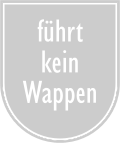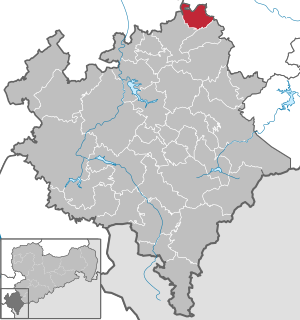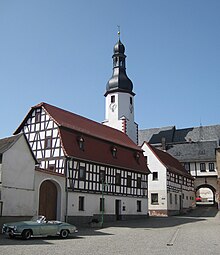Neumark (Vogtland)
| coat of arms | Germany map | |
|---|---|---|

|
Coordinates: 50 ° 39 ' N , 12 ° 21' E |
|
| Basic data | ||
| State : | Saxony | |
| County : | Vogtland district | |
| Height : | 373 m above sea level NHN | |
| Area : | 17.31 km 2 | |
| Residents: | 2964 (Dec. 31, 2019) | |
| Population density : | 171 inhabitants per km 2 | |
| Postal code : | 08496 | |
| Area code : | 037600 | |
| License plate : | V, AE, OVL, PL, RC | |
| Community key : | 14 5 23 280 | |
| Community structure: | 3 districts | |
| Address of the municipal administration: |
Markt 3 08496 Neumark |
|
| Website : | ||
| Mayor : | Sven Köpp ( FDP ) | |
| Location of the municipality of Neumark in the Vogtlandkreis | ||
The Saxon community of Neumark is located in the Vogtlandkreis .
geography
Geographical location
Neumark is located northeast of the large district town of Plauen in an open landscape area of the Central Vogtland hill country , surrounded by gentle valleys and numerous wooded hills at an altitude of 373 m. The old mining town of Zwickau is only 15 kilometers away . Numerous streams and rivers flow in the immediate vicinity . Not far from Neumark are the Pleißenquelle as well as the Weiße Elster , Zwickauer Mulde and Göltzsch . The Oberneumarker Bach and the Schönbacher Bach unite in the village itself.
Expansion of the municipal area
Seen from the topography , Neumark is a "border town". The community lies at the transition between the natural areas of Vogtland (Middle Vogtland Kuppenland), Thuringian Slate Mountains ( East Thuringian-Vogtland Plateau ) and Ore Mountains Basin (Upper Pleißeland). A quarter of the agricultural area is used for forestry and the remaining part is used for arable and grassland management .
Neumark lies on the northeast border of the Saxon part of the historic Vogtland . The Thuringian district of Greiz borders in the northwest, and the Saxon district of Zwickau in the north and east .
Neighboring communities
Neighboring communities are Heinsdorfergrund and Reichenbach in the Vogtlandkreis, Fraureuth and Lichtentanne in the Zwickau district and Mohlsdorf-Teichwolframsdorf in the Greiz district in Thuringia .
Community structure
The community is divided into Neumark (with Oberneumark and Untersteumark ), Reuth and Schönbach .
climate
The local vegetation period is 200 to 210 days with an annual mean temperature of 9 ° C. The main wind direction is west.
geology
The site is located on a subsoil consisting of granite , greywacke , slate and diabase , which is covered with fertile brown earth and enables the cultivation of potatoes, corn, wheat and other demanding crops. Numerous disused quarries in the Neumark region still indicate that the green stone diabase was intensively mined.
history
Neumark was first mentioned in 1225 as novum forum (= new market). The name of the place indicates that it was a place with market rights . The first settlers came from Franconia , Thuringia and Bavaria . They cleared the existing forest and thereby gained arable and pasture land. The original settlement form of the elongated and formerly independent villages Unter- and Oberneumark corresponded to a forest hoof village . There was a castle in the village . However, this was destroyed during the Vogtland War by the troops of Emperor Charles IV . The Zwickau merchant Martin Römer built a new palace in late Gothic form after 1478.
Neumark tried to become a town in the early days, as can be seen in a community and market letter from 1530, which certifies Neumark market fairness . The Lords of Römer campaigned for a renewal of the market rights, as can be seen in an electoral deed from 1669. The von Römer family had a great influence on the development of the community. Among other things, she donated the altar, the Lord's Supper and three stained glass windows to the Neumark Church. Sidonie von Römer paid the school fees for the children of the manor and in 1886 the von Römer family contributed financially to the construction of the station tunnel. With the connection to the railway network from 1846, the textile industry in Neumark gained increasing importance. Before 1900 there were already five textile factories employing around 1,000 people.
The manor over Neumark was exercised by the manor Neumark of the Römer family until the 19th century. Neumark, like its present-day districts, initially belonged to the "Care Schönfels ", which was incorporated into the Electoral Saxon or Royal Saxon Office of Zwickau in the Ore Mountains in the 16th century . In 1856 Neumark was affiliated to the Reichenbach court office and in 1875 to the Plauen administration . In 1920 Neumark was assigned to the Werdau administration . As a result of the dissolution of the administrative district, the town and its current districts came to the Zwickau district administration in 1933, which from 1939 was called the Zwickau district.
As a result of the second district reform in the GDR , the municipality of Neumark became part of Reichenbach in the Chemnitz district in 1952 (renamed the Karl-Marx-Stadt district in 1953 ), which was continued as the Saxon district of Reichenbach from 1990 and became part of the Vogtland district in 1996.
Incorporations
| Former parish | date | annotation |
|---|---|---|
| Oberneumark | July 1, 1950 | |
| Reuth | January 1, 1994 | |
| Schönbach | January 1, 1994 | |
| Sub-brand | October 1, 1937 | with part of the community Erlmühle |
Population development
Development of the population (December 31) :
|
|
|
- Data source from 1998: State Statistical Office Saxony
Memorials
A grave site with a memorial stone in the local cemetery commemorates seven unknown concentration camp prisoners who were thrown to death from the train during an evacuation transport from Auschwitz and buried here.
politics
City council and mayor
Since the municipal council election on May 26, 2019 , the 14 seats of the municipal council have been distributed among the individual groups as follows:
- CDU : 4 seats
- FDP : 4 seats
- SPD : 1 seat
- Pro Neumark, Reuth, Schönbach: 1 seat
- Independent voters: 4 seats
The mayor is Sven Köpp (FDP).
Town twinning
- since 1990 with Roetgen in the Aachen city region
Culture and sights
The oldest part of the place is the central market . This is surrounded by old farmsteads , some of which are built in impressive half-timbered houses. From here there is a passage to the church square as well as the rectory and the church of Neumark. The town hall and the municipal administration are also located directly on the market . The sights of Neumark also include the school museum in the primary school (Oberneumarker Straße) and the home parlor from 1620.
In just a few minutes' walk you can also reach the manor with its large estate and Neumark Castle, which is located on a hill above it and is surrounded by an English-style park that was laid out in 1872 . The manor was originally owned by a von Neumark dynasty and in 1478 came to the Zwickau Römer family , who had been ennobled in 1470. The purchaser, Martin Römer , founded the silver mining industry in Schneeberg and thus acquired a large fortune. He had the old Neumark castle replaced by a castle in late Gothic form. As governor of Zwickau, he also built important buildings in his hometown and acted as a patron . In 1500 the estate came to Markward von Hermannsgrün and in 1544 to von Wolframsdorf . In 1633 it was sold to Moritz Haubold von Schönberg until it was acquired again in 1649 by the von Römer family, who then owned it until it was expropriated as part of the land reform . From 1990 the manor, parts of the land and finally the castle were bought back by Benno von Römer .
Economy and Infrastructure
Established businesses
At the end of the town there is a striking building belonging to the BayWa company , which was built in 1970 as a concentrate mixing plant ( feed & silage ) . In the industrial park there is a SGB-SMIT location , a Deutsche Post parcel center and several smaller companies. In addition, there is a maintenance and repair center for the Regentalwerke of the Länderbahn in Neumark , in which, among other things, Vogtlandbahn trains are serviced.
traffic
Neumark is on federal highway 173 .
The Neumark (Sachs) train station on the Leipzig – Hof railway line is served by the Vogtlandbahn . Neumark is located near the Werdau triangle , which connects the Saxony-Franconia Magistrale and the Leipzig – Hof railway line. The next larger train stations are in Werdau and Reichenbach in Vogtland .
Until 1997 there was a passenger train connection from Neumark to Greiz ( Neumark – Greiz line ).
Personalities
- Ernst Ahnert (1859–1944), (parliamentary) stenographer , including Bismarck's speeches (1895) and at the Versailles peace negotiations (1919); Co-creator of today's German shorthand ; lived and worked in Zwickau, Varel / Friesland, Oschatz and Dresden
- Uwe Grüning (* 1942), writer and politician (CDU), Member of the State Parliament , media council , has lived in Neumark since 1993
- Frank Dünger (1961–2006), football player
literature
- Erich Börner: Neumark - history of a little town. Edited by Erich Börner. Geiger-Verlag, Horb am Neckar 1991, ISBN 3-89264-599-X .
- Richard Steche : Neumark. In: Descriptive representation of the older architectural and art monuments of the Kingdom of Saxony. 11th booklet: Amtshauptmannschaft Plauen . CC Meinhold, Dresden 1888, p. 44.
Web links
- Neumark in the Digital Historical Directory of Saxony
Individual evidence
- ↑ Population of the Free State of Saxony by municipalities on December 31, 2019 ( help on this ).
- ↑ The manor Neumark on www.sachsens-schlösser.de
- ^ Website of the Neumark community
- ^ Karlheinz Blaschke , Uwe Ulrich Jäschke : Kursächsischer Ämteratlas. Leipzig 2009, ISBN 978-3-937386-14-0 ; P. 64 f.
- ^ The Plauen District Administration in the municipality register 1900
- ↑ https://www.wahlen.sachsen.de/wahlverbindungen-2019-nach-gemeinden-6690.html?_cp=%7B%22accordion-content-6693%22%3A%7B%2228%22%3Atrue%7D% 2C% 22previousOpen% 22% 3A% 7B% 22group% 22% 3A% 22accordion-content-6693% 22% 2C% 22idx% 22% 3A28% 7D% 7D
- ↑ Hans Sauer: A stenographer from Varel near Bismarck. Ernst Ahnert, pioneer of the "art of speech drawing" in the Oldenburger Land. In: Kulturland Oldenburg. Journal of the Oldenburg landscape. Issue 165 (3.2015), ISSN 1862-9652 , pp. 20-23 ( PDF ; 3952 kB; accessed on March 9, 2016).









